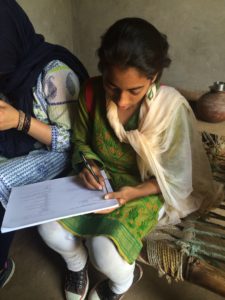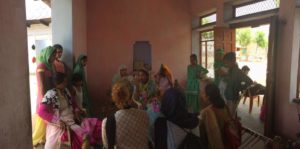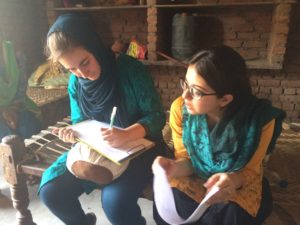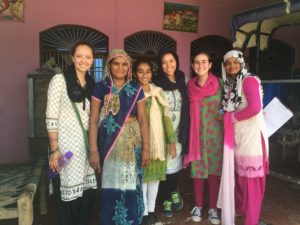In order to evaluate the impact that the Nourish international interns that intended to implement the Swachh Bharat mission in the villages of Gebhar, Baroji and Bajheda, we conducted a questionaire in a sample population of each one of the villages. Our process consisted of using both systematic and stratified sampling techniques, choosing every third household from each of our strata, which represent categories of the population and their implementation of toilets since the completion of last year’s project, or lack thereof, in addition to those who are in the process of constructing them. Our Impact Assessment questionnaire consisted of questions regarding the construction of toilets, the usage of toilets, the sanitation practices of the household, and the information retention of the workshops conducted the previous year.
(Prerana Krishnan conducting the Impact Assessment questionaire in the village of Gehbar)
During our first field visit, we only had one translator available to conduct the questionnaires and thus had to remain in one team. The Nourish Interns were in charge of noting the responses from these surveys on the physical questionnaire as well as making any necessary notes for qualitative results. The field team which consisted of two field staff, three interns and one translator completed 11 surveys in the village of Gebhar, 14 surveys in the village of Baroji.
(Field team conducting an Impact Assessment questionnaire in the village of Baroji)
During our second field visit we had another translator on the team. This meant we were able to divide the work load from the third and largest village between two groups, each with Nourish international Interns, field staff and a translator. Group divided the total amount of surveys in the sample equally and in proportion to their category (constructed a toilet in the past year, does not have a toilet, toilets that are currently under construction); 23 surveys were completed in the village of Bajheda.
(Rachel Feldman and Shruti Kipur conducting an interview for the Impact Assessment in the Village of Bajheda)
In the office we began compiling the answers from all three villages into an excel sheet in order to begin interpreting the results. These results will be separated into three sections; Information retention, Health and toilet use/construction. While conducting the surveys we ran into some issues concerning the reporting of having a toilet, as well as continuing problems concerning water availability. We made note of the fact that some individuals might have wrongly reported having a toilet in order to receive compensation from the government, as well as the social constrains of people that have not yet built a toilet. The qualitative notes we made during the field will help us better understand and explain the quantitative data we arrive at.
(Stephanie Muench, Anganvari worker, Prerana Krishnan, Jackie Bornstein, Rachel Feldman and Field Staff in the village of Gebhar)
One of our goals is to inform the community about the many opportunities they have to receive funding from the different government schemes that are in place to support sanitation practices in rural India. In the impact assessment this is evaluated as the information retention from the workshops conducted in the villages last year by the previous interns. The results from these questionnaires will help us develop and adapt the way we conduct the workshops in the villages of Mundheta and Naseerpuri to acheive a better and more detailed information retention by the community.
-Stephanie Muench




